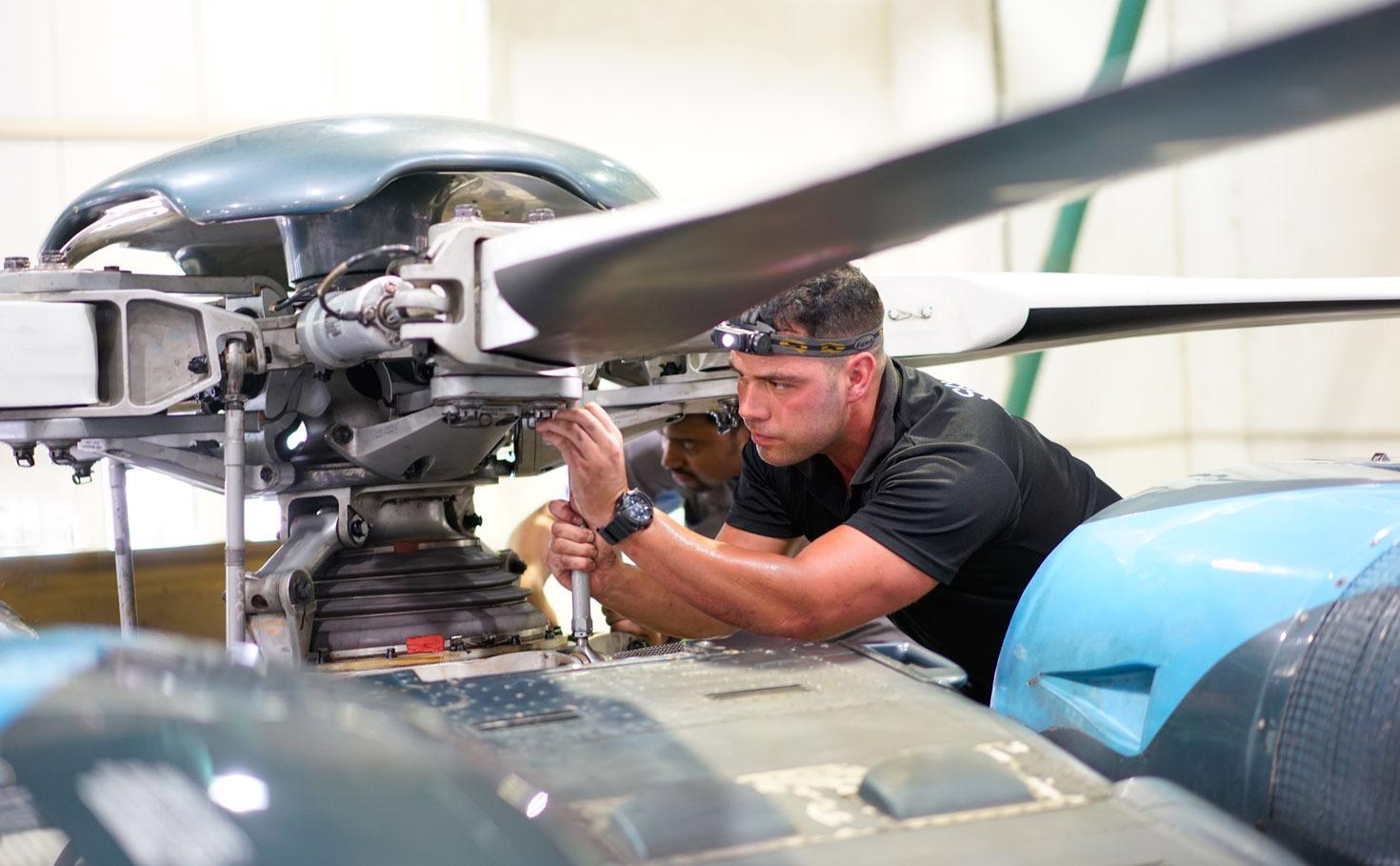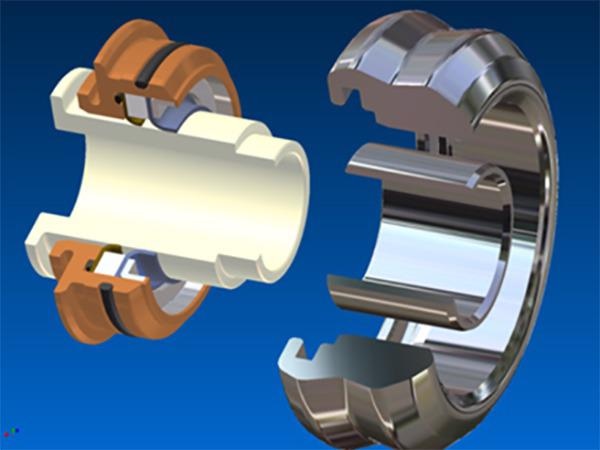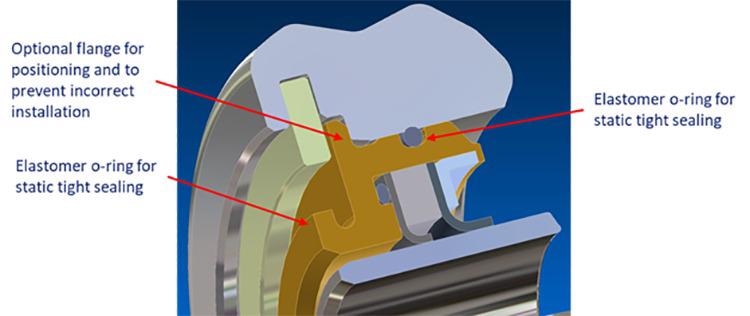The aviation sector has long been regarded as a lifeline for communities, providing the only rapid worldwide transportation network and generating global economic development. With so many people to support on a daily basis, commercial and military manufacturers need reliable partners to keep aircraft and helicopters safe and cost-effective. Partners who develop, engineer, and/or manufacture advanced sealing technology fit this critical need.

Seals serve many purposes and are used in many core systems. In jet engines, for example, two of the main purposes are to restrict leakage from coming out of a system and to prevent contaminants from entering a system. When selecting a seal, there are many criteria that must be considered such as installation and assembly; temperature and pressure; contact and non-contact; wear and friction; and rotational and surface speeds.
Polymer rotary lip seals play an integral role in improving aircraft engine efficiency at a high performance to cost ratio. Failure of this critical part results in major safety, environmental, and cost hazards. There are a number of proven reasons why aviation manufacturers depend on lip seals such as Omniseal Solutions Omniseal® rotary lip seals as they provide a tighter fit and enhanced performance over elastomer counterparts. They also require less space than mechanical carbon face seals in turbine shafts and external gearboxes. Additionally, they can cope with temperatures ranging from -65 °F to 350 °F (-53 °C to 177 °C) and pressures up to 25 PSI (0 to 1.7 BAR) with a typical surface velocity of 2,000 to 4,000 ft. per minute (10 to 20 m/s). Several of Omniseal Solutions sealing solutions in this area can run at speeds of over 20,000 feet per minute, which is equivalent to 102 meters per second.
At Your (Long Lasting) Service: Rotary Lip Seals in Commercial & Military Applications
The engine is no doubt one of the most crucial parts within the aircraft; therefore, its maintenance is often the key priority for airlines. Despite longer-lasting aircraft and more durable engines, airlines now spend more on maintenance than on fuel or crew. Lip seals are being used more in external gearboxes for major aircraft engine manufacturers. As engine technology advances, so does sealing technology as can be seen in geared turbofan jet engines that also use Omniseal Solutions lip seals. This type of engine sports a gear system that separates the engine fan from the low-pressure compressor and turbine, allowing each module to operate at optimal speeds. As a result, they can offer advanced efficiency. Around a half-gallon of fuel burnt per mile in a typical airliner, this more efficient engine is expected to save an average of $1.7 million in operating costs per airliner per year.
Along with supporting commercial industry needs, these rotary lip seals can also be found in military applications, in particular for the Department of Defence, with critical uses in fighter jets, aircraft carriers, and helicopters. Omniseal Solutions PTFE lip seals are used on a wide range of military aircraft including the following areas:
- Lift fans for vertical lift
- Helicopter gearbox engines
- Rotor head (swashplate)
- Ram Air Turbine gearbox
- Wing flap and slat actuators
- Critical equipment in arresting systems to catch the aircraft as it lands on the deck
It is incredibly important that the above equipment is maintained properly but also does not fail. Aside from being extremely resilient, other lip seal advantages include ease of installation and replacement versus mechanical seals, much less space to be integrated into hardware, and compact design in accessory gearboxes for jet engines but also all accessories connections on turboshaft engines.
Due to flexible custom designs with a precise fit in existing hardware, Omniseal Solutions Omniseal® lip seals are qualified for helicopter rotor head and transmission retrofit programs. These solutions were selected for challenging aviation applications, including several with linear speed in excess of 90 m/s.
Evolving PTFE Solutions: Rotary Lip Seals Become The Viable Choice
How did rotary lip seals become so valuable in aviation? Shaft seal materials originally evolved from using felt and leather to including elastomer. By the 1960s, PTFE materials began to emerge as a viable material. After years of unsuccessful trials in various applications, understanding of the material processing and seal design eventually improved, which drove its reach into initial markets involving diesel engines for trucks. PTFE seals later reached the aviation market in the late 1970s and 1980s.
Omniseal Solutions Omniseal® lip seal solution goes back forty years and has become a critical part of the aviation, life science, and automotive markets. The business created their polymer lip seal to bridge the gap between elastomer lip seals and mechanical seals. The temperature resistance, self-lubrication properties, high wear resistance, and inertness to chemical attack of Omniseal Solutions Fluoroloy® filled PTFE materials were proven to greatly exceed the working range of elastomer seals.
Over the years, typical applications included sealing high speed rotating shafts in aircraft engines and gearboxes that were subjected to a wide range of temperatures, pressures, and other dynamic conditions. Seal designs have evolved progressively to integrate new features; they are still continuing to evolve and be developed to meet customer and market needs, representing a state-of-the-art solution in the sealing industry. Specific and more tailored applications for PTFE lip seals are found in sealing rotating shafts, in particular those with high speed, offering an excellent alternative to elastomer rubber lip seals if the conditions are challenging and exceed their capabilities.
Engineering A Unique Sealing Solution: Omniseal® Tailored Lip Seal Design
Did you know that Omniseal® PTFE lip seals do not use extension springs for sealing in the majority of cases? Instead, these seals respond to any loads applied to the stretching of the sealing lip and bend radius produced by the metal casings. When compared to elastomer lip seals, Omniseal Solutions PTFE lip seals use a far wider lip to shaft contact pattern. Their PTFE lip seals also make use of a lighter unit loading, but a wider footprint. Their design has taken this engineering direction in order to address the wear rate, and these changes were made to lower the unit loading, which is also known as PV.
The design of Omniseal® lip seals integrates optional features depending on the application:
- Single to triple lip configurations to prevent leakage or repel pollutants
- Spring loading for high shaft runout
- Hydro-threading to pump back potential leakage
Designs for mechanical seals/carbon face seals are popular as options for high shaft speeds; however, their cost is typically higher. They also require a controlled volume of lubrication which leads to an overall costlier, heavier, and bulkier system. They also require tight control of the axial shaft movement, which is much less the case for lip sealing technology. While PTFE lip seals benefit from lubrication, they generally operate without a dedicated lubrication channel and are much easier to install (see Figure 1).

Figure 1: Seals can be shipped on a mandrel that protects the seal and can be used as an installation tool. With this equipment, field replacement is much easier.
Handling Extreme Speed & Providing Self-Lubrication: Omniseal® Lip Seal Critical Functionality in Airplanes & Helicopters
Omniseal® lip seals are typically used to seal oil at high rotational shaft speeds as widely utilized in large aircraft gearboxes or helicopter rotor heads. Aircraft gearboxes are critical parts as they are used to reduce the main engine shaft’s rotational speed from as high as 26,000 rpm down to about 3,400 rpm, so the shaft can drive such system components as hydraulic pumps, generators, and air conditioning compressors.
The reliability of PTFE lip seals makes them suitable for sealing on the engine main shafts. One of Omniseal Solutions specific lip seal design enables surface speeds above 65 m/s (13,000 ft/min) with excellent durability (above 20,000 hours), even with high temperatures (up to 150°C to 300°F). As lubricants are progressively moving to HTS (High Thermal Stability) oils to cope with higher engine temperatures, the inertness of PTFE versus aggressive media reinforces the interest of this technical solution.
In smaller aircraft such as helicopters, control is key since they are indeed incredibly complex machines (miracles of intricate engineering) that take real skill to fly. Since its invention, they have proved to be valuable in everyday life, most notably as a reliable mode of transport for tricky rescue or humanitarian missions – rescuing stranded sailors from the sea, dumping loads of water onto forest fires, or transporting the critically injured to hospital.
An example of where Omniseal® PTFE lip seals support is in the helicopter swashplate with typical sizes going up to 18’’ (~46 cm) in diameter. The self-lubrication properties of PTFE are particularly appreciated for such applications, as dry-run conditions are possible when a loss of lubrication occurs. Wiper sealing elements can be added to prevent dust and particles from entering the system. To work effectively, OmniSeal® lip seals require a hard shaft surface (typical Rockwell Hardness from 50 to 62 HRc) and a relatively smooth surface (from 0.5 to 0.2, down to 0.15 for ceramic coatings).
In both airplanes and helicopters, Omniseal® lip seal designs integrate features related to its installation and removal, simplifying the overall use of the seal in aircraft systems. The seals can be customized to accommodate all conditions including speeds, pressures, temperature range, and media to provide the ideal solution for the given application (see Figure 2).

Figure 2: Cross-sectional view of the seal on a housing gland. A static O-ring on the outer diameter of the seal insures tight sealing between the seal and mating housing bore. The O-ring can provide static sealing and anti-seal rotation or a metal press-fit can also be included. A flange feature can be added to create a positive stop and to prevent the seal from being installed backward.
Due to the high temperature, high pressure, and high speeds in this application example, heat generated on the sealing surfaces results in wear and deterioration of parts, shortening their life. High temperatures may also alter the seal geometry and result in heavy leakage rates. One of the main problems associated with these seals is wear due to friction caused by high rotational speeds. Research has been done in this area, investigating the factors that affect the frictional behavior of seals.
Looking Into The Future: New Generation Aircraft & Lip Seals
New-generation aircraft are considered to be those that have been designed and built after 2000. They are an investment in modern cutting-edge technology to complement the enhanced design of new airliners. This ranges from improved materials, i.e., carbon fiber composites, special coatings and hybrid alloys to new data collection and measurement tools designed to provide advanced prognostication capability. With its low weight, intrinsic simplicity of integration and low encumbrance, Omniseal Solutions Omniseal® rotary lip seal will be more than ever a relevant solution for the current and next generation of aircraft engines and gearboxes as well as helicopter applications.

This information has been sourced, reviewed and adapted from materials provided by Omniseal Solutions.
For more information on this source, please visit Omniseal Solutions.